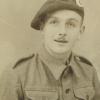The Battle for Happy Valley, Tunisia 1943.
Submitted by Neville Robinson, who was in 2 Para's Intelligence Section in Tunisia.
In February 1943 we left 11 Infantry Brigade and rejoined 1 Parachute Brigade to take over from a French Foreign Legion Battalion near Safsa in a valley we got to call ‘Happy Valley’.
The Foreign Legion Battalion was composed of 90% Spaniards who had fought against Franco in the Spanish Civil War and had escaped over the Pyrenees into France where the French had interned them and given them some choices, one of which was to sign up for the Legion.
The French had left behind their Artillery to support us, but they had no English speakers amongst them so our Battalion CP ran a telephone line directly to the guns and since I spoke French I was sent to the gun position to translate the target grid reference, bearings, etc so that the Gun Position Officer [GPO] could understand what was required.
On arrival I was greeted and shown around the gun position, the first thing I noticed was that the guns had large wooden wheels and that they were buried in deep pits with a ramp of dirt at the front of each pit. I was told that the guns were 75mm’s of 1914 - 1918 vintage and had been hidden in caves in French Morocco away from the eyes of the German Armistice Commission and that the gunners had conducted secret gun drills in the caves in the mountains. They were looking forward to being equipped with US Army 105 mm Howitzer’s ‘soon’, but till then the 75mm was it.
On the 26th the enemy attacked all three rifle companies with Italian Alpini on the right and Austrian Jager [Edelweiss] troops on the left, the Battalion 3” Mortars and the Vickers Medium Machine Guns [MMG’s] controlled by ‘Bombs’ Panter did sterling work, and the French 75’s were hauled out of their pits [by hand] and produced some rapid fire that was a sight to behold. As the range increased the guns were pulled onto the dirt ramps so that they could fire in the upper register but not very accurately as the GPO kept advising me. The battle ended that night with about 150 Italian and Austrian casualties with only 1 dead and 2 wounded from the Battalion.
During the last phase of firing I noticed that only two guns were firing and that the ammunition was being brought to them to fire the other guns. I asked the GPO who said he hoped we wouldn’t ask for any more as he was firing the last of his ammunition!
I suppose there wasn’t much 1914 -1918 75mm ammunition lying about in Tunisia at that time. The following day I got orders to return to Battalion HQ and was told that John Frost had been very pleased with the performance of those rapid firing wooden wheeled relics of the1914 - 1918 Great War. I had really enjoyed my time with the Moroccan Gunners not only because I was put on ration strength and thus drew a litre of ‘Vin Ordinaire’ from the battery ‘Sergeant Chef’ every day, but also because I admired the way they made do with out-dated equipment and little of anything.
A couple of days later we were relieved by an American Combat Team from the US 9th Division, and their CO in conversation with John Frost noted that “in war you gotta get the atmosphere” as he decided to move the Battalion CP from the rear to the forward slope. We hurried down the hill to the waiting Bedford TCV’s before he could make the final decision! We then moved North to the Djebel Abiod area where we moved forward to Cork Wood and took over from the Lincoln’s to begin the heaviest fighting of the Tunisian campaign.
The following photograph was taken after we came out of the line in Tunisia and I got my boots cleaned for the first time in many months! The khaki Drill uniform had just been received as we were in Battledress all the Winter in Tunisia, the trousers had those leather pocket liners which were such a pain!
This is a copy of the Leave Pass into Algiers, I was issued on 3 April 1943 from the Orange grove where we slept after we were relieved by the 9th US Army Division RCT in front of Green Hill and Baldy.
The Officer was a Captain Elliott was then both IO and Adjutant, I believe he was later killed at Ringway doing some experimental jumps. Please note that my rank was still ‘Rifleman’ as we still used the original Rank Titles and at one stage we had a saying in the Int Section, “There are no ‘Private Soldiers’ in 2 Para I Section”, because the four of us were a ‘Guardsman’, a ‘Rifleman’ a ‘Fusilier’ and a ‘Trooper’ [that was about Jan 43].
At that time [in April 43] the strength of the Battalion was about 170 men and I was the sole member of the Int Section so the pass is written by me and signed by the Adjt/I.O, he crossed out ‘OC BHQ’ that I had written in my ignorance of his true title ‘Captain & Adjutant’, by the way I was 18 & a half years old when this photo was taken.
End.
Source:
Researched by R Hilton
Read More




Latest Comments
There are currently no comments for this content.
Add Comment
In order to add comments you must be registered with ParaData.
If you are currently a ParaData member please login.
If you are not currently a ParaData member but wish to get involved please register.